Other
- Summer Palace (2006 film), a 2006 Chinese-language film directed by Lou Ye
- Summer Palace (album), a 2008 album by UK band Sunny Day Sets Fire
- "The Summer Palace" (Succession), an episode of the television series Succession
Summer Palace is a Qing dynasty palace in Beijing, China.
Summer Palace may also refer to:

A palace is a grand residence, especially a royal residence, or the home of a head of state or some other high-ranking dignitary, such as a bishop or archbishop. The word is derived from the Latin name palātium, for Palatine Hill in Rome which housed the Imperial residences. Most European languages have a version of the term, and many use it for a wider range of buildings than English. In many parts of Europe, the equivalent term is also applied to large private houses in cities, especially of the aristocracy; often the term for a large country house is different. Many historic palaces are now put to other uses such as parliaments, museums, hotels, or office buildings. The word is also sometimes used to describe a lavishly ornate building used for public entertainment or exhibitions such as a movie palace.

The Forbidden City is a palace complex in Dongcheng District, Beijing, China, at the center of the Imperial City of Beijing. It is surrounded by numerous opulent imperial gardens and temples including the 22 ha (54-acre) Zhongshan Park, the sacrificial Imperial Ancestral Temple, the 69 ha (171-acre) Beihai Park, and the 23 ha (57-acre) Jingshan Park. It is officially administered by the Palace Museum.
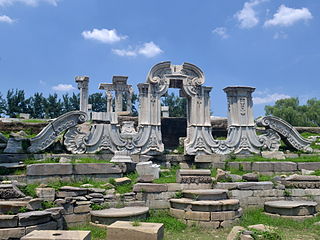
The Old Summer Palace, also known as Yuanmingyuan or Yuanmingyuan Park, originally called the Imperial Gardens, and sometimes called the Winter Palace, was a complex of palaces and gardens in present-day Haidian District, Beijing, China. It is 8 kilometres (5.0 mi) northwest of the walls of the former Imperial City section of Beijing. Widely perceived as the pinnacle work of Chinese imperial garden and palace design, the Old Summer Palace was known for its extensive collection of gardens, its building architecture and numerous art and historical treasures. Constructed throughout the 18th and early 19th centuries, the Old Summer Palace was the main imperial residence of Qianlong Emperor of the Qing dynasty and his successors, and where they handled state affairs; the Forbidden City was used for formal ceremonies. The Garden was reputed as the "Garden of Gardens" in its heyday was "Arguably the greatest concentration of historic treasures in the world, dating and representing a full 5,000 years of an ancient civilization" said: Robert McGee, chaplain to the British forces.

Tsarskoye Selo was the town containing a former residence of the Russian imperial family and visiting nobility, located 24 kilometers (15 mi) south from the center of Saint Petersburg. The residence now forms part of the town of Pushkin. Tsarskoye Selo forms one of the World Heritage Site Saint Petersburg and Related Groups of Monuments.
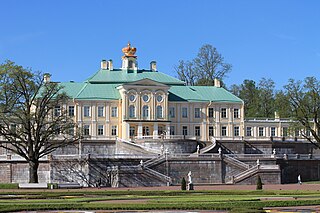
Oranienbaum is a Russian royal residence, located on the Gulf of Finland west of St. Petersburg. The Palace ensemble and the city centre are UNESCO World Heritage Sites.

Pavlovsk is a municipal town in Pushkinsky District in the suburban part of the federal city of St. Petersburg, Russia, located 30 kilometers (19 mi) south from St. Petersburg proper and about 4 kilometers (2.5 mi) southeast from Pushkin. Population: 16,087 (2010 Census). Known since the late 18th century, when Saint Petersburg was the capital of Russian Empire, as a countryside residence of Russian royal family commissioned creation of the town's landmark -palace with a large park, now parts of its federal museum reserve.

Strelna is a municipal settlement in Petrodvortsovy District of the federal city of Saint Petersburg, Russia, about halfway between Saint Petersburg proper and Petergof, and overlooking the shore of the Gulf of Finland. Population: 12,452 (2010 Census); 12,751 (2002 Census).
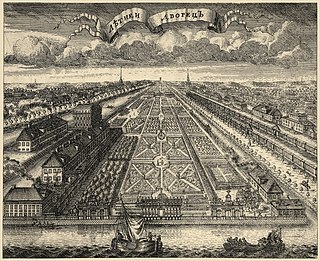
The Summer Garden is a historic public garden that occupies an eponymous island between the Neva, Fontanka, Moika, and the Swan Canal in downtown Saint Petersburg, Russia and shares its name with the adjacent Summer Palace of Peter the Great. Its inception dates back to early 18 century when Russia took these lands from Sweden in the Great Northern War. Being a monument of landscape architecture featuring original and copied sculptures of classical mythology characters, a former royal palace and a monument to the fable author Ivan Krylov, the garden is now a branch of the Saint Petersburg-based national art treasury Russian Museum.
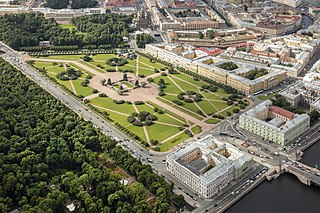
The Field of Mars is a large square in the centre of Saint Petersburg. Over its long history it has been alternately a meadow, park, pleasure garden, military parade ground, revolutionary pantheon and public meeting place.
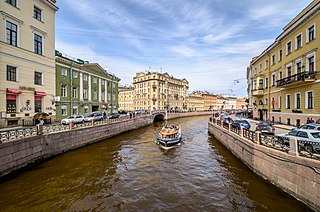
The Moyka is a secondary, in comparison with the Neva River in Saint Petersburg that encircles the central portion of the city, effectively making it an island or a group of islands, together with the Neva, the Fontanka, and canals including the Griboyedov and Kryukov. The river derives its name from the Ingrian word Muya for "slush" or "mire", having its original source in former swamp. It is 5 kilometres (3 mi) long and 40 metres (130 ft) wide.

Ekaterinhof or Catherinehof is a historic island park that began as an 18 century empress's estate in the south-west of St Petersburg, Russia. Its name originated in 1711, when Peter the Great presented the Island and adjacent lands along the eponymous Ekateringofka River to his wife Catherine, whose name they memorialize.

A Chinese palace is an imperial complex where the court, civil government, royal garden and defensive fortress resided. Its structures are considerable and elaborate. The Chinese character gong represents two connected rooms (呂) under a roof (宀). Originally the character applied to any residence or mansion, but it was used in reference to solely the imperial residence since the Qin dynasty.
The appearance of Saint Petersburg includes long, straight boulevards, vast spaces, gardens and parks, decorative wrought-iron fences, monuments and decorative sculptures. The Neva River itself, together with its many canals and their granite embankments and bridges help to give the city its particular ambience.

The Winter Palace is a palace in Saint Petersburg that served as the official residence of the House of Romanov, previous emperors, from 1732 to 1917. The palace and its precincts now house the Hermitage Museum. Situated between Palace Embankment and Palace Square, adjacent to the site of Peter the Great's original Winter Palace, the present and fourth Winter Palace was built and altered almost continuously between the late 1730s and 1837, when it was severely damaged by fire and immediately rebuilt. The storming of the palace in 1917, as depicted in Soviet art and in Sergei Eisenstein's 1928 film October, became a symbol of the October Revolution.

Saint Petersburg, formerly known as Petrograd (1914–1924) and later Leningrad, is the second-largest city in Russia. It is situated on the Neva River, at the head of the Gulf of Finland on the Baltic Sea. The city had a population of roughly 5.6 million residents as of 2021. Saint Petersburg is the fourth-most populous city in Europe, the most populous city on the Baltic Sea, and the world's northernmost city of more than 1 million residents. As Russia's Imperial capital, and a historically strategic port, it is governed as a federal city.

The Peterhof Palace, is a series of palaces and gardens located in Petergof, Saint Petersburg, Russia, commissioned by Peter the Great as a direct response to the Palace of Versailles by Louis XIV of France. Originally intending it in 1709 for country habitation, Peter the Great sought to expand the property as a result of his visit to the French royal court in 1717, inspiring the nickname of "The Russian Versailles". The architect between 1714 and 1728 was Domenico Trezzini, and the style he employed became the foundation for the Petrine Baroque style favored throughout Saint Petersburg. Also in 1714, Jean-Baptiste Alexandre Le Blond, likely chosen due to his previous collaborations with Versailles landscaper André Le Nôtre, designed the gardens. Francesco Bartolomeo Rastrelli completed an expansion from 1747 to 1756 for Elizabeth of Russia. The palace-ensemble along with the city center is recognized as a UNESCO World Heritage Site.

The Summer Palace of Peter the Great was built in Saint Petersburg between 1710 and 1714 in the northeast corner of the Summer Garden, located on an island formed by the Fontanka River, Moyka River, and the Swan Canal. Its northern perimeter runs along the left bank of the Neva River across from the Cabin of Peter the Great and Peter and Paul Fortress and was the first palace built in Saint Petersburg, the second largest city in Russia.
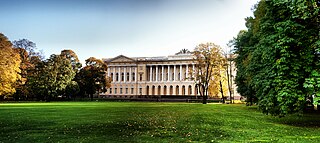
The Mikhailovsky Garden is a large area of parkland and landscape garden in the centre of Saint Petersburg.